Suzuki Swift Super 1600 Evo 2: Suspension
Very tricky part that bothered me until my friend J-F gave me the solution. The symptom: straight line-corner-roll over. Funny at the beginning but soon it becomes annoying, especially when you are of the "trigger happy" kind like me. In fact, the reason is quite simple: when entering the corner, the weight is mainly transfered to the front of the car and make the front suspension work. That's Logic. The problem is located at the rear: when the suspension is not smoother than the front's, the inner corner rear wheel will lift since the opposite damper doesn't compress enough. Thus roll over.
Solution: a rear suspension soft than the front's. Given this is an on-road chassis, my first idea was to set a stiff suspension. For purposes of equity (synonym for ignorance and laziness), the four dampers were set the same. Taking J-F's advice into consideration, the rear was now softer thanks to softer springs: roll over problem solved.
But another problem immediately rose: the car was heavily vibrating anytime I pushed throttle hard. It couldn't be a problem with the motor since I was using the Mabuchi 540. Here again, suspension was badly setup: more precisely, it was too stiff at the front.
Definitive solution: 2-hole pistons for all 4 dampers, but "medium" springs at the front and "soft" at the rear. As soon as this setup was made, the car got well balanced. Roll overs are rare and always due to my "trigger happy" driving skills. Based upon the precious advices from the Aussie band at RC-Mini, to find the chassis balance is the most important factor for an M-Chassis and I do confirm it provides a much improved driving pleasure.
Something else can contribute to the chassis suspension balance: anti-roll bars (aka sway bars). They are a must on some chassis (like the M-02):
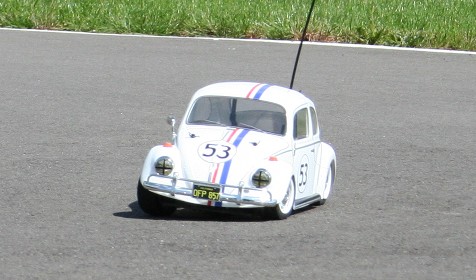
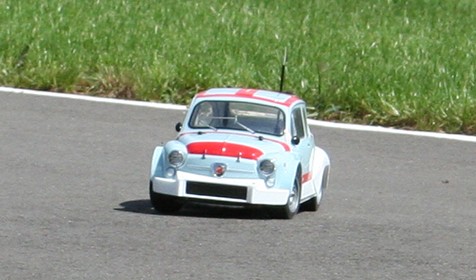
For the M-03 chassis, you can read several statements and their exact opposite: some people swear they are required and others just do fine without. Difficult to know the truth but I think the suspension setup is the key (dampers stiffness). In my opinion, a good dampers setup is enough to forget about anti-roll bars: but if you have problems finding the correct chassis balance, then anti-roll bars are the easy way. On my side, I found the correct suspension balance but I have anti-roll bars on hand: so I will try them to see if I can feel any difference when driving. But once more, you first need to find the correct chassis balance before to think about anti-roll bars.
Tires:
Now the chassis is well balanced, no need to touch it anymore but it is time to focus on grip.
In addition to being a front-wheel drive chassis, the M-03 is remarkably quick: this is the best receipe to wear the stock tires bald in 10 packs. Better said: in 5 packs, the front tires will show already severe wear, but after running them 10 packs, they will get bald like a baby's butt. By the time, the rear tires will suffer a half wear. You might think it would be smart to swap front and rear wheels: big mistake! The M-03 being front-wheel drive, the rear drivetrain is the most important for overall chassis balance: always prefer the best tires at the rear, even if this means the front may slide (the steering will help to control it).
Just imagine the tire wear considering the first photo below was shot after only a 10 minutes race (please note the mirrors are still there, which proves the photo was shot soon after my model hit the track ![]() ) :
) :
Tire debris on the bodyshell (and spread all over the chassis)
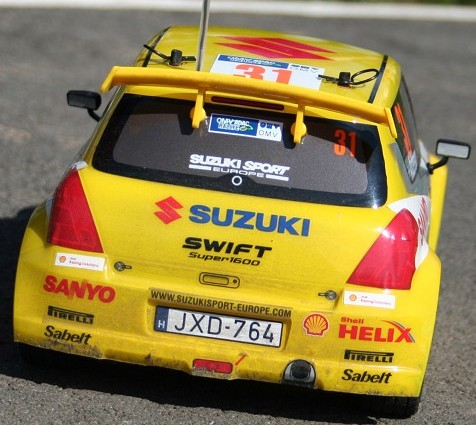
Front tire after running 7 battery packs
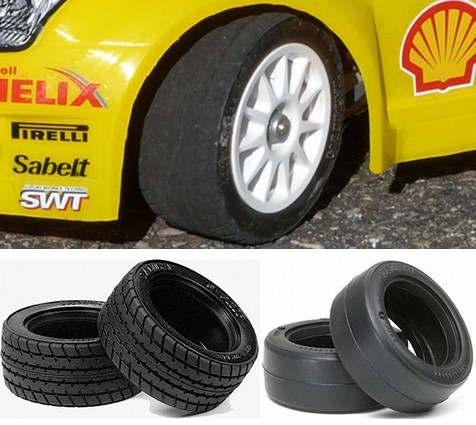
The option tires (53254 60D S-Grip radial or 54216 60D Reinforced Tires Type B slick) offer much better grip and will make the chassis even more quick: there are required once your stock wheels got bald. Also note tire diameter has an influence... in theory. There are two kind of M-Chassis tires: 55D (55mm diameter) and 60D (60mm diameter). Both can suit any M-chassis rim since the inner diameter is the same. But the size difference means a 9% top speed difference in favor of the 60D compared to the 55D. But it does mean an identical torque performance drop when accelerating. Choosing either size is all about aesthetic considerations related to the bodyshell shape. Let's be concrete: 9%, considering the value remains constant all track long (ie the track has no corners), represent 0.5 second in a 1 minute lap. In theory. In the real life, alternating corners and straight lines will cancel any difference. But above anything, the driver will make the difference.
Talking about tires, don't forget inserts (also called inner sponges or foams): their role is important. By reinforcing the tire from the inside, they stiffen the tire walls (avoiding chassis roll) and provide a better contact surface between the tire and the ground, thus a better grip (to be exact, they stiffen the tire contact surface with the ground avoiding it to be altered by track irregularities). Whatever foam band can do the job, provided you like spending time to cut it to the right dimensions. In concrete, hard inserts reference 53255 for 60D tires are the best solution (they also exist for 55D tires).
I also tried to install classic 1/10th wheels from any TT-01, TA-01, TL-01 etc...: this time, the size difference is about 18%. The real track test shows that the stock 540 silver can with the 20T motor pinion goes as fast as an other 55D wheels M-chassis powered by a Sport Tuned motor (18T motor pinion) ![]() . Of course, this was just for fun (and look) since it is much more fun when all cars have the same setup.
. Of course, this was just for fun (and look) since it is much more fun when all cars have the same setup.
But my yellow Suzuki looks way more aggressive:
With 60D tires
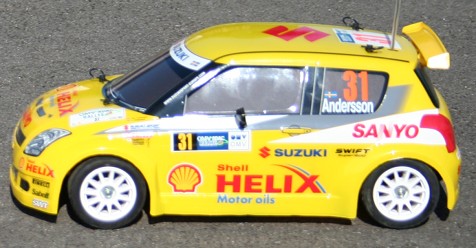
With classic 1/10th wheels
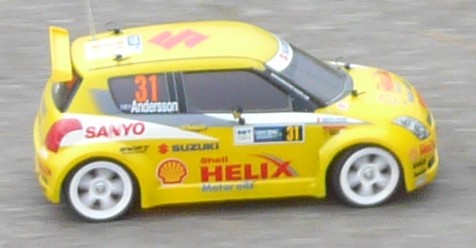
Even if this proved to be definitely useless on a track, give this mod a try if you have 1/10th wheels available, just for fun (but they may not fit every bodyshell wheel arches).
Handy useless things:
As with every chassis, many options are available for the M-03, some contributing to performances or comfort at usage when others are just for decoration.
53346 Quick Battery release
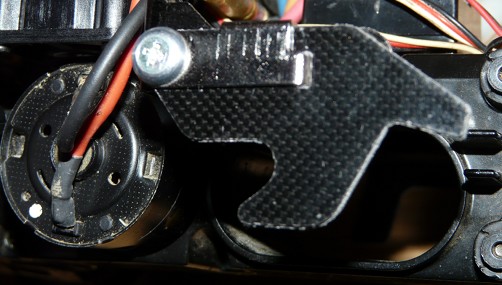
53056 Pin Type Wheel Adapters
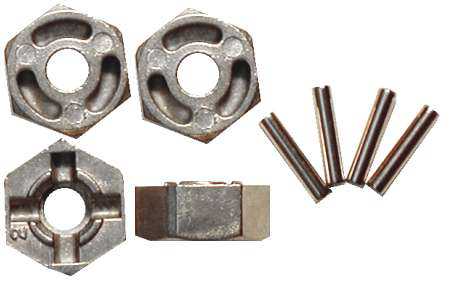
For me, those two options are among the useful but not required, even if at usage, they quickly turn into must have. The battery retention system is very helpful even though it is certainly more fragile than the standard system. About the aluminum wheel adapters, I install them on all my models since they never get trapped into the rims and never wear or break.
Now the considerably less useful parts:
3Racing motor heatsink (M03M-21/SI)
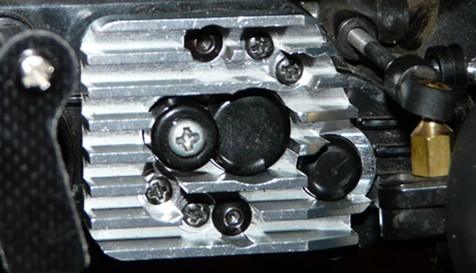
3Racing cooling fan (M03M-09/LB)
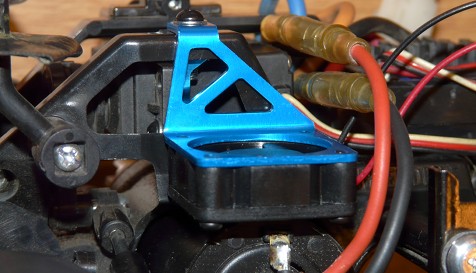
From those two, the most effective must be the fan... well, almost ![]() . The motor heatsink doesn't have a chance to evacuate heat since the heat transfer can only come through the motor screws: the thermal exchange surface is rather limited. The equivalent option from Tamiya(reference 53344) lacks the same efficiency since this is due to the chassis layout. Now the motor cooling fan that simply fits above it: at its best, the fan may unlikely give the motor a cold but will never make it colder
. The motor heatsink doesn't have a chance to evacuate heat since the heat transfer can only come through the motor screws: the thermal exchange surface is rather limited. The equivalent option from Tamiya(reference 53344) lacks the same efficiency since this is due to the chassis layout. Now the motor cooling fan that simply fits above it: at its best, the fan may unlikely give the motor a cold but will never make it colder ![]() .
.
Among other available options for M-03, I think the only valuable ones are the adjustable turnbuckles (to fine tune drivetrain settings) and aluminum uprights (toe-in/out setup). I consider the rest to be about cosmetics and/or overweight.
Overall handling:
Very difficult to describe the M-Chassis if you never had the chance to see one and above all, to drive one. It is very quick in corners, fast in straight lines and quick to re-accelerate, even when power by the Mabuchi 540 stock silver can. To some extend, the handling makes me think of a mix between my Racing Master and my FF-01.
When taking it first in hands, it is surprisingly easy to drive despite being a front wheel drive chassis. But don't think it is boring and that easy. The best is to share the track with friends running cars with the same setup. I definitely highly recommend this chassis to anyone who wants to makes its debuts on-road, but also to everyone who think 1/10th 4WD classic chassis are boring to drive unless you fit them with more power than a Mabuchi 540 silver can.
Future evolution of my Suzuki Swift Super 1600:
Honestly, you can drive this model for years and have great moments without changing anything to it. Once you have found the suspension balance, this chassis is a blast to drive. With my friends from the Team Vintage Racing, we have decided to get even more spice out of our M-Chassis runs: our models will now be fitted with the Sport Tuned motor and an 20T motor pinion. Even quicker, even faster, even more fun!
Related articles:
- 58163 Rover Mini Cooper '94 Monte-Carlo - M-01
- Toyota Celica LB Turbo Group 5 - M-02
- Lancia Stratos HF Rallye Monte-Carlo 1977 - M-04




